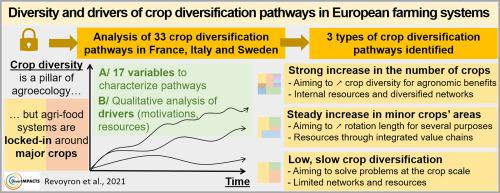Agricultural Systems ( IF 6.1 ) Pub Date : 2022-06-10 , DOI: 10.1016/j.agsy.2022.103439 Eva Revoyron , Marianne Le Bail , Jean-Marc Meynard , Anita Gunnarsson , Marco Seghetti , Luca Colombo

|
CONTEXT
Diversified cropping systems are a main pillar of agroecological practices, but their development is hindered by technological lock-in of agri-food systems around a few major crops. There are only a few examples where minor crops successfully developed and stabilized in a given agricultural region. The underlying change processes at play in these situations are not well known.
OBJECTIVE
Our paper draws on successful crop diversification experiences, and more specifically on analyses of why and how farms change towards diversified cropping systems, with a view to identifying levers to further enable crop diversification.
METHODS
We selected three regions in Europe (Vendée in France, Marche in Italy and Skåne in Sweden) where minor crops are present and carried out interviews on 33 farms where these crops had recently been introduced. The interviews aimed at retracing the farms' crop diversification pathways and the drivers thereof. Farmers were asked to explain their motivations for diversifying their crops and the resources they mobilized to do so. Using a combination of variables to describe the evolution of crop diversity and farmers' behavior towards diversification crops, we statistically categorized the crop diversification pathways into three distinct patterns.
RESULTS AND CONCLUSIONS
The three types of crop diversification pathways identified differed in the following respects: their crop diversity evolution dynamics; the levels of crop diversity reached; and the nature of the change processes that supported them. Type 1 farmers diversify slowly, based on crop-by-crop comparisons of performances. They mobilize few external resources. Type 2 farmers steadily increase crop diversity by introducing a few minor crops on large areas. They are driven by combined economic and agronomic or work-related motivations, and supported by the downstream actors buying the crops. Type 3 farmers diversify rapidly and significantly, driven by agronomic motivations on the benefits of crop diversity for the crop succession. They look for leeway and flexibility in their decisions by mobilizing a variety of outlets and networks.
SIGNIFICANCE
This is the first time that crop diversification is analyzed as a long-term (ten to twenty years) change process on farms, with a comparative analysis of three contrasting European regions. Our results indicate that support to crop diversification should be tailored according to farmers' agronomic, economic and work-related issues- especially at the level of the crop succession and the farm. Outlets for diversification crops need to be thought out in terms of the level of external support and autonomy they provide to farmers.
中文翻译:

欧洲农场作物多样化途径的多样性和驱动因素
语境
多样化的种植系统是农业生态实践的主要支柱,但其发展受到围绕几种主要作物的农业食品系统的技术锁定的阻碍。只有少数几个例子表明小作物在特定农业地区成功发展和稳定。在这些情况下起作用的潜在变化过程并不为人所知。
客观的
我们的论文借鉴了成功的作物多样化经验,更具体地说,分析了农场为何以及如何向多样化种植系统转变,以期确定进一步实现作物多样化的杠杆。
方法
我们选择了欧洲三个种植小作物的地区(法国旺代、意大利马尔凯和瑞典斯科讷),并对最近引进这些作物的 33 个农场进行了采访。访谈旨在追溯农场的作物多样化途径及其驱动因素。农民被要求解释他们使作物多样化的动机以及他们为此调动的资源。使用变量组合来描述作物多样性的演变和农民对多样化作物的行为,我们将作物多样化途径统计分类为三种不同的模式。
结果和结论
确定的三种作物多样化途径在以下方面有所不同:它们的作物多样性演变动态;达到的作物多样性水平;以及支持他们的变革过程的性质。基于逐个作物的表现比较,第 1 类农民缓慢地多样化。他们调动的外部资源很少。2 型农民通过在大面积上引入一些小作物来稳步增加作物多样性。它们受到经济和农艺或与工作相关的综合动机的驱动,并得到购买作物的下游行为者的支持。在农艺动机的推动下,第 3 类农民迅速而显着地实现了作物多样性对作物演替的好处的多样化。他们通过动员各种渠道和网络在决策中寻求回旋余地和灵活性。
意义
这是第一次将作物多样化分析为农场的长期(十到二十年)变化过程,并对三个对比鲜明的欧洲地区进行了比较分析。我们的研究结果表明,对作物多样化的支持应根据农民的农艺、经济和工作相关问题进行调整——尤其是在作物继承和农场层面。需要根据他们为农民提供的外部支持和自主权的水平来考虑多样化作物的出口。











































 京公网安备 11010802027423号
京公网安备 11010802027423号